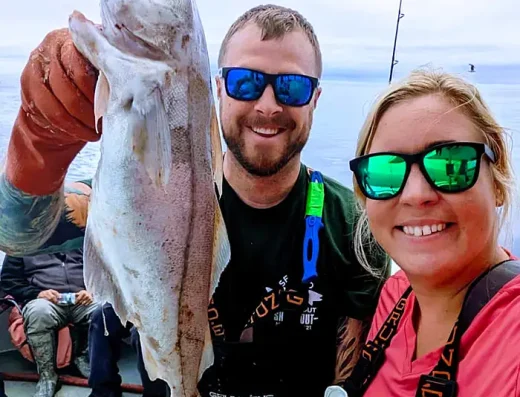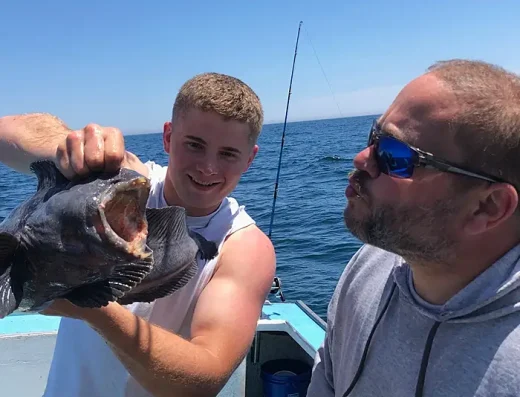Kittery Fishing Charters
Kittery fishing charters work the inshore ledges, rocky points, and tidal rivers for striped bass, bluefish, and groundfish, with offshore runs chasing tuna and sharks in the Gulf of Maine.
Top Rated Charters in Kittery
TrustedFish connects anglers with proven local captains in Kittery, Maine —no commissions, no pay-to-play listings, no BS. Every charter on our platform is invite-only, vetted for skill, local knowledge, and reputation. If they’re listed, they’ve earned it.
Kittery, ME Fishing Guide
Kittery sits at the southern tip of Maine, right where the Piscataqua River meets the Atlantic, giving charter captains easy access to both protected inshore waters and deep offshore grounds. Half-day trips often work the river mouth, rocky shorelines, and nearshore ledges for striped bass, bluefish, and mackerel. Full-day charters may push farther out into the Gulf of Maine to target haddock, pollock, cod, and on the right days, bluefin tuna. The local fishery is structured around a mix of tidal rivers, rocky bottom, offshore humps, and deep channels. Running distances vary — inshore trips can start fishing within 15 minutes of leaving the dock, while tuna runs may head 20–40 miles offshore. Key launch points include Kittery Point and the public ramp upriver in Eliot, with some captains also working out of nearby Portsmouth Harbor.
The season kicks off in late spring with striped bass pushing into the river and along the beaches. Summer brings steady striper action, plus bluefish, mackerel, and offshore groundfish. Tuna start showing up mid to late summer. Fall sees the inshore bite peak as stripers fatten up for migration, with tuna and groundfish trips still running offshore. Winter fishing is limited here, though some hardy crews run specialized cod or haddock trips if conditions allow.
Techniques vary by target — light tackle casting and live-lining mackerel are standard for stripers, while jigging and bait rigs work offshore for haddock and cod. Trolling is common for tuna, and some captains will drift chunk baits for sharks. Fly anglers can find opportunities in the river for stripers during calmer days. Nearby waters like the Isles of Shoals and Jeffreys Ledge expand the fishing range for those willing to make the run.
Spring
As the water warms in May, striped bass start pushing into the Piscataqua River and working the rocky shoreline. The early bite is often best on live mackerel or soft plastics drifted in the current. Haddock and cod remain a good offshore option, with most trips targeting them by anchoring over structure and fishing bait rigs. Spring weather can be unpredictable, but lighter boat traffic and aggressive fish make it a prime time for inshore anglers
Fishing Seasons in Kittery
Spring (March–May)
As the water warms in May, striped bass start pushing into the Piscataqua River and working the rocky shoreline. The early bite is often best on live mackerel or soft plastics drifted in the current. Haddock and cod remain a good offshore option, with most trips targeting them by anchoring over structure and fishing bait rigs. Spring weather can be unpredictable, but lighter boat traffic and aggressive fish make it a prime time for inshore anglers.
Summer (June–August)
Summer offers the widest range of options. Striped bass and bluefish feed heavily around river mouths, ledges, and island points, with mackerel easy to jig up for bait. Offshore, haddock, pollock, and cod remain steady, while bluefin tuna begin to arrive in deeper water off Jeffreys Ledge. Many charters split the day, starting inshore for stripers before heading offshore for groundfish or tuna. Early mornings and tide changes are key for the inshore bite.
Fall (September–November)
Fall is prime striper time, with schools feeding aggressively ahead of migration. The action is often fast along rocky points and beaches, and fish will hit topwater plugs readily. Tuna fishing can be excellent offshore through October, with sharks also in the mix. Cooler water helps groundfish action, and offshore trips tend to see bigger haddock and pollock. Fall weather windows can be short, so flexibility is important.
Winter (December–February)
Most charter activity slows in winter, but a few operations run cold-weather trips targeting cod, haddock, and redfish offshore when the seas allow. The inshore fishery is largely dormant, though some locals still fish the river for holdover stripers. Conditions can be challenging, with cold temps and short days, so trips are weather-dependent and geared toward experienced anglers willing to brave the elements.
Gamefish in Kittery
- Striped Bass – 20–40 inches. Found along rocky shorelines, river mouths, and ledges from late spring to fall; taken on live mackerel, plugs, and flies.
- Bluefish – 5–15 pounds. Summer to early fall around inshore structure and chasing bait schools; hit topwaters and spoons.
- Atlantic Mackerel – 10–16 inches. Jigged nearshore in summer; also prime live bait for stripers and tuna.
- Haddock – 3–7 pounds. Caught offshore on bait rigs over hard bottom, mostly spring through fall.
- Pollock – 5–20 pounds. Found on deep offshore structure year-round; jigging is most effective.
- Cod – 5–25 pounds. Targeted offshore in cooler months on baited rigs near wrecks and ledges.
- Bluefin Tuna – 100–800 pounds. Summer through fall on the offshore grounds; trolled, chunked, or live-baited.
- Shortfin Mako Shark – 100–300 pounds. Targeted in summer offshore with drifted baits or chum slicks.
Kittery Fishing FAQs
What are the main launch points for fishing charters in Kittery?
Most Kittery charters launch from Kittery Point or nearby ramps on the Piscataqua River, with some operating out of Portsmouth Harbor just across the river.
How long are typical fishing trips here?
Half-day trips run four to five hours, often staying inshore for striped bass and mackerel. Full-day trips can run eight to ten hours, targeting a mix of inshore and offshore species.
What fishing gear is provided on Kittery charters?
Captains supply rods, reels, tackle, and bait. Many also include lures for casting and jigging, along with ice for keeping the catch fresh.
Do I need a fishing license to fish in Kittery?
Anglers on licensed charter boats do not need to purchase their own Maine saltwater fishing license. If fishing on your own, a license is required for tidal waters.
When is the best time to fish in Kittery?
Late spring through fall offers the most variety, with prime striped bass action from June to September and tuna peaking in late summer.
What techniques are common on Kittery charters?
Light tackle casting, live bait drifting, vertical jigging, bottom fishing, trolling, and chunking for tuna are all used depending on the season and target.
What species can families expect on a short trip?
Half-day family trips often focus on striped bass, mackerel, and bluefish, offering plenty of action close to shore without long runs.
Can I keep my catch from a Kittery fishing trip?
Yes, within state and federal regulations. Captains will clean and fillet legal fish for you to take home.
Do charters offer specialty trips?
Some captains offer tuna-only trips, shark fishing, or fly fishing charters for striped bass during peak season.


